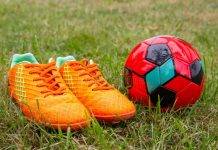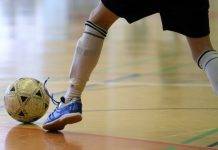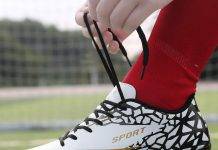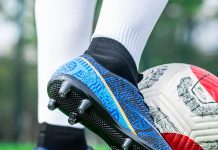Soccer is an incredibly popular sport among kids, and getting the right equipment is essential for them to perform their best on the field. That’s why it’s crucial to understand how kids’ soccer cleats should fit. Finding the perfect fit is not only about comfort but also about improving their skills and preventing injuries. In this article, we will explore the importance of properly fitting soccer cleats and provide helpful tips to ensure your child’s feet are supported and ready to take on the game. So, let’s get started and discover the best way to give your young soccer stars the right footing they deserve.
Choosing the Right Size
When it comes to choosing the right size for your child’s soccer cleats, it’s essential to understand the different sizing systems. Soccer cleats are typically labeled with either US sizes or European sizes, so make sure you know which system the brand you’re considering follows. To ensure an accurate fit, it’s crucial to measure your child’s foot properly.
Review contents
Understanding Different Sizing Systems
The US sizing system for soccer cleats is typically the same as regular shoe sizes, but it’s always a good idea to check the specific brand’s size chart for any variations. European sizes, on the other hand, often use a different numbering system. For example, a US size 5 might be labeled as a European size 37. It’s crucial to refer to the brand’s size chart for accurate conversions between different sizing systems.
Measuring Your Child’s Foot
To measure your child’s foot, you’ll need a ruler or tape measure. Ensure that your child is standing and their foot is flat on the ground. Measure the length of their foot from the heel to the tip of their longest toe. If their measurements fall between sizes, it’s generally best to opt for the larger size to allow for growth and ensure comfort.
Considering Growth Room
Kids grow rapidly, and their feet are no exception. When selecting soccer cleats, it’s important to consider growth room. Look for cleats with about a thumb’s width of space between the tip of the longest toe and the end of the shoe. This will allow room for growth and prevent discomfort or potential injuries caused by tight-fitting cleats.
Fit and Comfort
Fit and comfort are key considerations when choosing soccer cleats for your child. Proper fit ensures optimal performance on the field and minimizes the risk of blisters, foot pain, or other discomforts that can hinder their enjoyment of the game.
Toe Space
Soccer cleats should have enough space in the toe area to allow for natural movement of the toes. The toes should not be cramped or pressed against the front of the cleats. This space allows for proper balance, agility, and effective ball control.
Heel Support
Proper heel support is essential for stability and reduces the risk of injuries while running, stopping, or changing directions on the field. Ensure that the cleats provide a snug fit around the heel without causing discomfort or rubbing against the Achilles tendon.
Midfoot and Arch Fit
The midfoot and arch area should also be well-supported. Look for cleats that provide a secure, yet comfortable fit without being overly tight. This support helps in maintaining stability and preventing muscle strain.
Ankle Stability
Soccer involves quick movements, and ankle stability is crucial to prevent sprains and injuries. Ensure that the cleats provide adequate ankle support without restricting movement or causing discomfort.
Width of the Cleats
Different players have different foot widths, so it’s important to consider the width of the cleats. Soccer cleats are available in various widths, from narrow to wide, to accommodate different foot shapes. Choosing the right width will enhance the overall fit and comfort of the cleats.
Cleat Types
There are different types of soccer cleats designed for various field conditions. Understanding the different types will help you determine the most suitable ones for your child’s playing environment.
Hard Ground Cleats
Hard ground cleats have shorter and more numerous studs, which provide excellent traction on firm, dry surfaces. These cleats are ideal for playing on natural grass or artificial turf with a hard base.
Soft Ground Cleats
Soft ground cleats feature longer studs to provide traction on wet or muddy playing surfaces. The deeper studs help prevent the cleats from getting stuck in the softer ground, allowing for better maneuverability.
Artificial Turf Cleats
Artificial turf cleats usually have a greater number of shorter studs that offer optimal traction on artificial surfaces. These cleats are specifically designed to provide stability and minimize the risk of slippage on synthetic grass.
Indoor Cleats
Indoor soccer cleats, also known as futsal shoes, are designed for playing on indoor or hard-court surfaces. These cleats have a flat, non-marking sole that offers excellent grip and maneuverability on indoor playing surfaces.
Try Before Buying
While online shopping offers convenience, trying on cleats before buying is beneficial to ensure the perfect fit and comfort for your child. Visiting a store allows your child to try on different brands and styles to see what feels best for them.
Visiting a Store
Visiting a physical store gives your child the opportunity to try on cleats and feel the difference in fit, comfort, and features. Store staff can also provide valuable advice and guide you towards the most suitable options for your child’s needs.
Trying on Different Brands
Every brand has its own unique fit, and what fits one child comfortably may not be the best fit for another. By trying on different brands, you can determine which ones provide the best fit, comfort, and support for your child’s feet.
Walking and Running Tests
Encourage your child to walk and run around the store while wearing the cleats. This allows them to experience how the cleats feel during different movements and helps in assessing comfort, traction, and overall fit.
Consider the Style
While fit and comfort are paramount, considering the style of soccer cleats is also important. Different styles offer various features and options, and personal preferences play a role in choosing the right style for your child.
Lace-Up vs. Velcro
Soccer cleats come with different fastening systems, including traditional lace-up and Velcro closures. Lace-up cleats provide a customizable fit and better adjustability, while Velcro closures offer convenience, especially for younger children who may struggle with tying laces.
Low-Top vs. Mid/High-Top
Cleats are available in various heights, including low-top, mid-top, and high-top. Low-top cleats provide greater freedom of movement and lighter weight, while mid/high-top cleats offer more ankle support and stability.
Personal Preferences
Ultimately, your child’s personal preferences should also be taken into consideration. Let them choose a style they love and feel confident in, as this can contribute to their overall enjoyment of the game.
Playing Position
Your child’s playing position on the soccer field can also influence the type of cleats that are most suitable for them. Different positions require specific characteristics in a cleat to optimize performance and provide the necessary support.
Forwards and Attacking Midfielders
Forwards and attacking midfielders often prioritize cleats that provide excellent traction and allow for quick acceleration and sudden changes in direction. Cleats with a focus on agility, lightweight design, and excellent ball control are ideal for these positions.
Defenders and Defensive Midfielders
Defenders and defensive midfielders require cleats that offer stability, durability, and strong support for tackling and defensive maneuvers. Cleats with a more robust build, enhanced ankle support, and superior traction are suitable for players in these positions.
Goalkeepers
Goalkeepers need cleats that provide secure traction, agility, and stability to handle quick movements and fast reflexes. Cleats designed specifically for goalkeepers often have unique features, such as reinforced toe areas and additional padding.
Cleat Material
The material of soccer cleats affects their durability, comfort, and performance. Two popular options are leather and synthetic materials, each with its own advantages.
Leather Cleats
Leather cleats offer superior comfort, flexibility, and durability. They mold to the foot over time, providing a customized fit and excellent ball control. However, leather cleats may require more maintenance to keep them in optimal condition.
Synthetic Cleats
Synthetic cleats are lightweight, offer good durability, and require minimal break-in time. They are often more water-resistant than leather cleats, making them suitable for wet playing conditions. Synthetic materials also allow for more vibrant colors and unique designs.
Mesh Cleats
Mesh cleats provide excellent breathability and lightweight comfort. They are designed to keep feet cool and dry during play, making them ideal for hot weather or intense training sessions. However, mesh cleats may offer less durability compared to leather or synthetic options.
Breaking in the Cleats
New soccer cleats often require a break-in period to ensure optimal comfort and performance. Properly breaking in the cleats will help your child avoid discomfort and foot-related issues during games or practice sessions.
Gradual Wear
It’s important to ease into wearing new cleats gradually. Start by wearing them for short periods during practice or training sessions, gradually increasing the duration over time. This allows the cleats to mold to the shape of your child’s feet without causing discomfort.
Warm-Up and Stretching
Before wearing the cleats for an extended period, encourage your child to warm up and stretch their muscles. This helps prepare their feet for the increased activity and reduces the risk of discomfort or potential injuries.
Using Shoe Stretchers
If the cleats feel slightly tight in certain areas, you can use shoe stretchers to gently expand the material and create more room. This can be particularly helpful for leather cleats that need a bit of stretching to achieve a perfect fit.
Maintenance Tips
Proper maintenance of soccer cleats ensures their longevity and continued performance. Following a regular maintenance routine will keep the cleats in optimal condition and maximize their lifespan.
Cleaning and Drying
After each use, it’s essential to clean the cleats. Remove any excess dirt and debris with a soft brush or cloth. For stubborn stains, a mixture of mild soap and water can be used. Always air dry the cleats naturally to prevent damage or deformities, avoiding direct heat sources.
Storage
Proper storage is crucial to maintain the shape and condition of your child’s soccer cleats. Keep them in a well-ventilated area away from direct sunlight. Stuffing crumpled newspaper or using shoe trees can help preserve the shape of the cleats while they are being stored.
Replacing Worn-Out Cleats
Knowing when to replace soccer cleats is important to ensure your child’s safety and performance. Several signs indicate that it’s time for a replacement.
Outgrown Size
If your child’s feet have outgrown the current size of the cleats, it’s crucial to replace them promptly. Wearing cleats that are too small can cause discomfort, hinder performance, and potentially lead to injuries.
Visible Signs of Wear
Inspect the cleats regularly for signs of wear and tear, including worn-down studs, deteriorating materials, or loose stitching. If any visible damage or deterioration is noticed, it’s best to replace the cleats to maintain optimal support and performance.
Decreased Performance or Comfort
If your child experiences decreased performance or discomfort while wearing the cleats, it may be a sign that they need to be replaced. Pay attention to any changes in your child’s game and their feedback on the fit and feel of the cleats.
In conclusion, choosing the right size and fit for your child’s soccer cleats is essential for their comfort, performance, and overall enjoyment of the game. Understanding different sizing systems, measuring your child’s foot accurately, considering growth room, and trying on different brands are vital steps in finding the perfect fit. Additionally, factors such as cleat types, playing position, cleat material, and personal preferences all contribute to the overall fit, comfort, and performance of the cleats. By following proper maintenance tips and knowing when to replace worn-out cleats, you can ensure that your child’s soccer cleats provide the necessary support and durability for their soccer endeavors.





































